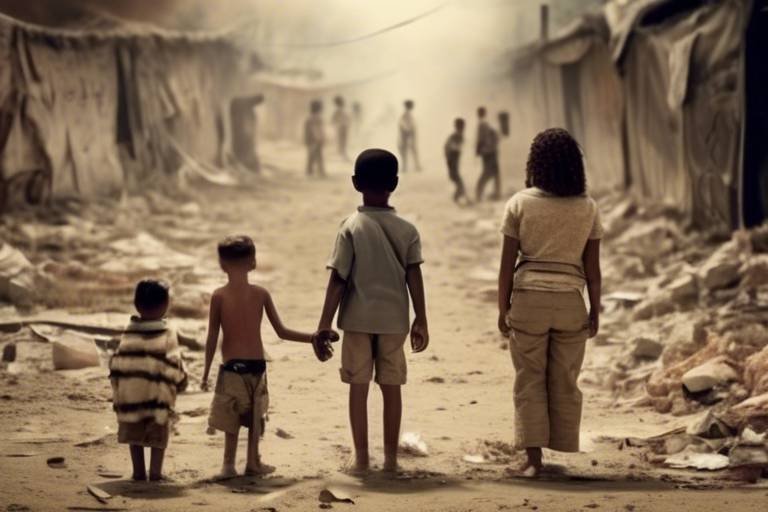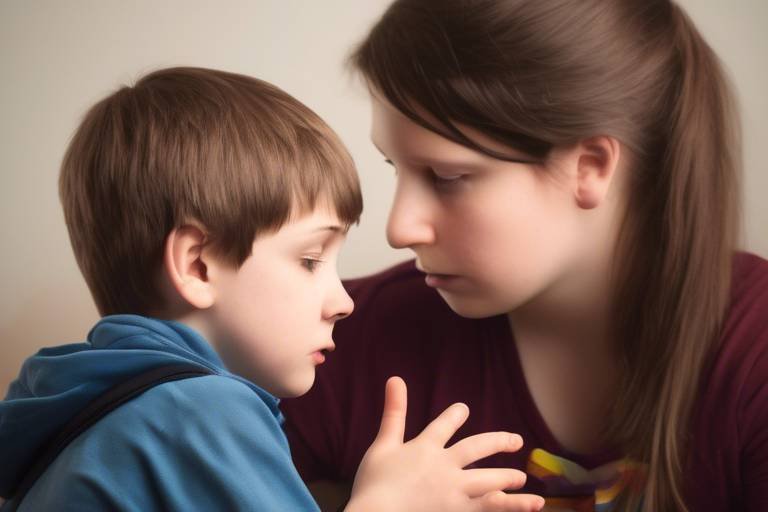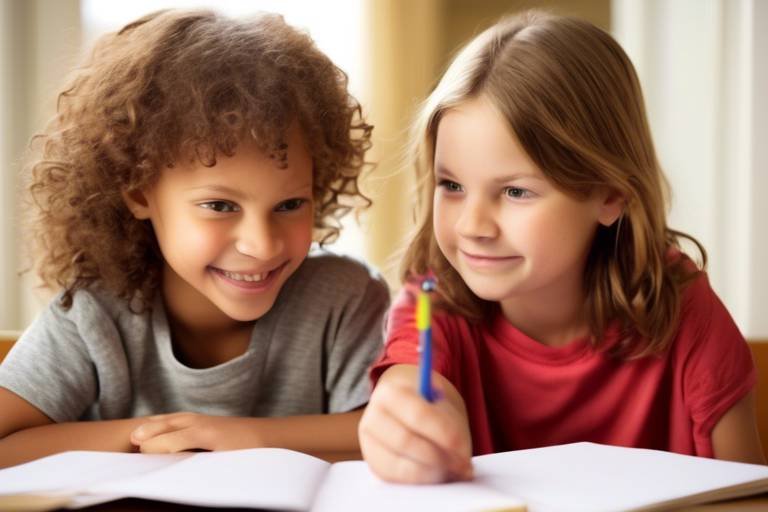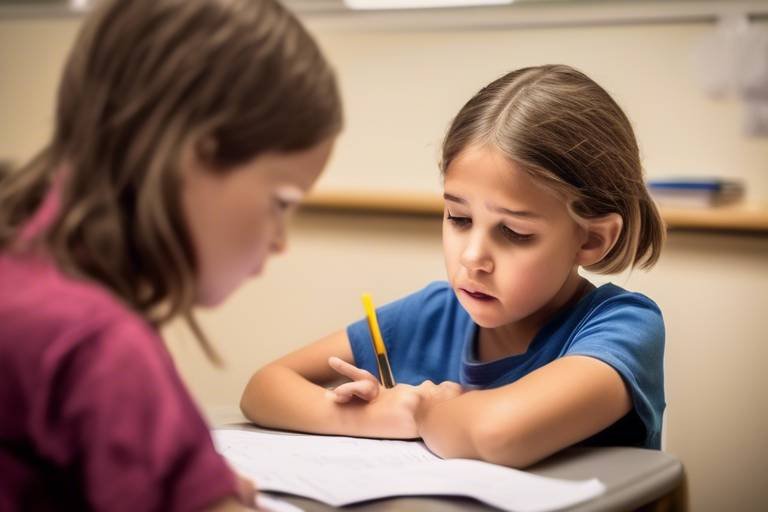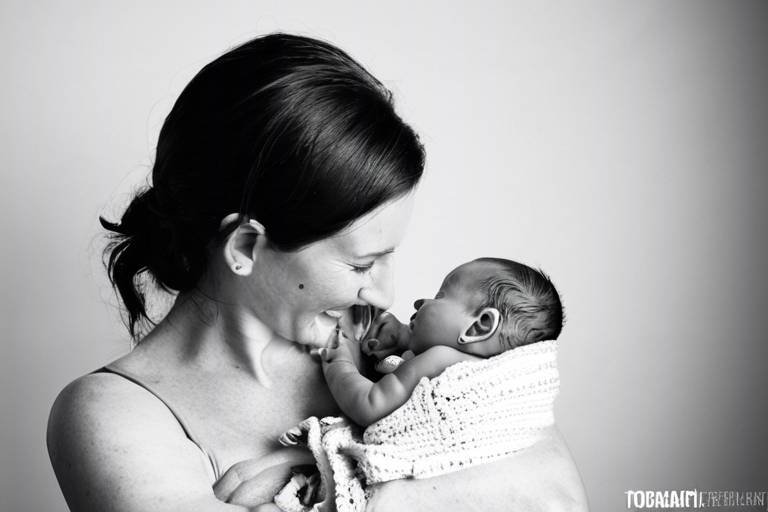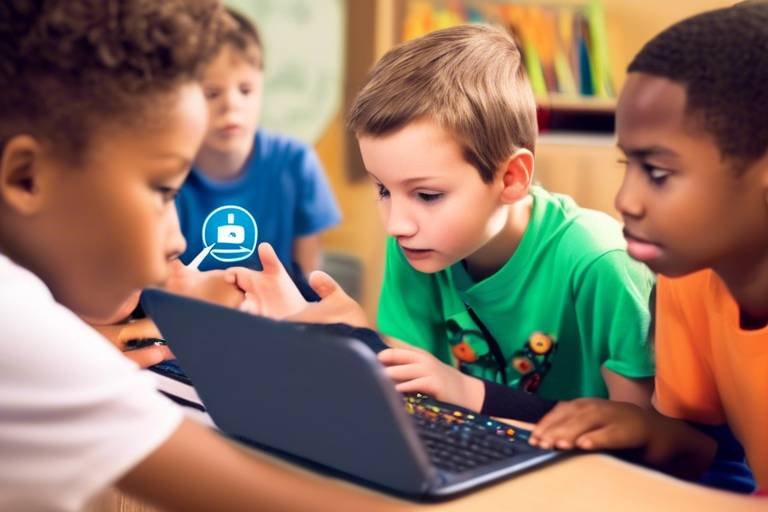Explaining World Events to Your Children
In today's fast-paced world, where news travels at the speed of light, it’s essential for parents to find effective ways to discuss complex global issues with their children. You might wonder, "How do I explain something as intricate as international relations or climate change to a child?" The answer lies in understanding your child's age and emotional maturity. By breaking down these topics into digestible pieces, you can foster a sense of understanding and empathy while encouraging critical thinking about the world around them. It’s like teaching them to ride a bike; you wouldn’t just throw them on without training wheels, right? You guide them, support them, and help them navigate the bumps along the way.
When it comes to discussing world events, using age-appropriate language is crucial. Children have varying levels of cognitive development, and what might make sense to you could be overwhelming to them. Imagine trying to explain the intricacies of the stock market to a five-year-old; it would be like trying to teach a puppy to play chess! Instead, focus on concepts they can relate to. For instance, when discussing poverty, you might use examples from their own lives, like how some friends might not have enough toys or food. This approach not only makes the conversation more relatable but also ensures that they grasp the information without feeling lost or confused.
Selecting suitable world events to discuss with children is equally important. You want to choose topics that are relevant to their lives and interests. For example, if your child loves animals, you could start with discussions about endangered species and conservation efforts. This makes it easier for them to engage in meaningful conversations about global affairs. Here are some tips on choosing topics:
- Relevance: Pick topics that connect with their daily experiences.
- Interest: Choose subjects that spark their curiosity.
- Complexity: Avoid overly complicated issues that could confuse them.
It’s essential to balance current events with historical context. Children often struggle to understand how past events shape today’s world. By providing a little background, you can help them connect the dots. For example, when discussing a current conflict, you might explain its historical roots, like how a long-standing rivalry or treaty impacts today's situation. This broader perspective fosters a deeper comprehension of ongoing issues, much like how knowing the backstory of a movie enriches the viewing experience.
Employing simple, clear language when explaining complex topics is vital. Think about it: if you were trying to explain a complicated recipe to someone who has never cooked before, you wouldn’t use culinary jargon. Instead, break it down into simple steps. Similarly, when discussing world events, avoid difficult jargon and instead use straightforward terms. For example, instead of saying "geopolitical tensions," you might say "countries not getting along." This approach helps children absorb information more effectively, allowing them to engage without feeling intimidated.
Encouraging children to ask questions is one of the best ways to create an open dialogue. When children feel comfortable asking questions, it not only helps them express their thoughts and feelings about world events but also promotes curiosity and critical thinking. You might say, "What do you think about that?" or "How does that make you feel?" This invites them into the conversation and helps them process the information. It’s like planting a seed; with the right nurturing, it can grow into a beautiful understanding of the world.
Various resources can aid in explaining world events to children. Consider using books, documentaries, and educational websites that present information in a kid-friendly manner. Visual and interactive learning opportunities enhance understanding and make the experience more engaging. For instance, you could watch a documentary together about climate change, followed by a discussion. This not only makes learning fun but also solidifies the concepts in their minds.
Teaching children to empathize with others affected by global events encourages compassion and a sense of responsibility. When children can understand that their actions or the actions of their country can impact others, they develop a more nuanced worldview. You might share stories of children from different backgrounds or cultures, helping them see the similarities and differences that make each person unique. This not only broadens their understanding but also makes them more compassionate individuals.
Introducing children to diverse perspectives on global issues promotes critical thinking and understanding. It's essential to help them appreciate the complexity of world events beyond a single narrative. For instance, when discussing a news story, you could present multiple viewpoints, asking them to consider how different people might feel about the same event. This approach encourages them to think critically and understand that issues are often multifaceted, much like a puzzle where every piece matters.
Involving children in discussions about world events encourages them to become informed citizens. You can help them feel empowered by discussing how they can make a difference, whether through community service, advocacy, or simply staying informed. This sense of agency is crucial; after all, they are the future leaders of our world. By fostering their engagement, you're not only helping them understand the complexities of global issues but also instilling a sense of responsibility to contribute positively to society.
Q1: What age is appropriate to start discussing world events with my child?
A1: It varies by child, but you can start introducing basic concepts as early as age 5. Tailor the complexity of the topics to their understanding.
Q2: How do I handle sensitive topics?
A2: Approach sensitive topics with care. Use simple language, be honest, and allow them to express their feelings. It’s okay to say, "I don’t know" if you're unsure about something.
Q3: What resources can I use to help explain these topics?
A3: Look for age-appropriate books, documentaries, and educational websites. Many organizations offer resources designed specifically for children.
Q4: How can I encourage my child to ask questions?
A4: Create a safe space for discussion. Encourage curiosity by asking open-ended questions and validating their thoughts and feelings.

The Importance of Age-Appropriate Communication
When it comes to discussing complex global issues with children, age-appropriate communication is absolutely essential. Think of it as choosing the right puzzle pieces for a child’s age—if the pieces are too big or too small, they simply won’t fit. Similarly, using language and concepts that resonate with a child's developmental stage can help them grasp intricate topics without feeling overwhelmed. For example, discussing climate change with a five-year-old might involve talking about how their favorite animals are affected, while a teenager might engage in deeper conversations about renewable energy and policy changes.
Moreover, age-appropriate communication fosters a sense of security. Children often look to adults for guidance, and when we present information in a way that is understandable, it reduces anxiety. They can absorb the information without feeling lost or confused, which is crucial in today’s fast-paced world where news can sometimes feel like a tidal wave crashing down. It’s not just about simplifying words; it’s about making connections that resonate. For instance, you might say, “Just like how we take care of our garden, we need to take care of our planet,” which creates a relatable analogy for younger children.
It’s also important to remember that children are naturally curious. If we use complex jargon or abstract concepts, we risk shutting down that curiosity. Instead, we should embrace their questions and encourage them to explore further. This can lead to rich discussions that not only inform them but also build their critical thinking skills. After all, when children feel comfortable asking questions, they are more likely to engage with the world around them.
To sum it up, here are a few key points to keep in mind when engaging in age-appropriate communication about world events:
- Know your audience: Tailor your conversation to the child's age and maturity level.
- Use relatable examples: Connect global issues to their everyday experiences.
- Encourage dialogue: Foster an environment where children feel safe to ask questions and express their thoughts.
By prioritizing age-appropriate communication, we not only help children understand the world but also empower them to be thoughtful, informed individuals who can navigate complex issues as they grow. So, the next time a big news story breaks, take a moment to consider how you can present it in a way that makes sense to the young minds around you.

Choosing the Right Topics
When it comes to discussing world events with children, is essential. You want to engage their interest while also ensuring that the issues are appropriate for their age and understanding. Think of it like picking the right book for a young reader; you wouldn’t hand a toddler a complex novel filled with adult themes, right? Similarly, selecting topics that resonate with their experiences can make the conversation more meaningful. For instance, children might relate better to discussions about climate change if they understand how it affects their local environment, such as seeing less snow in winter or more extreme weather.
Moreover, it’s important to consider the emotional maturity of your child. Some kids are more sensitive and might find certain topics distressing, while others might be more resilient. To navigate this, you can start with lighter, more relatable subjects, such as community events or stories of kindness and resilience in the face of adversity. As their understanding grows, you can gradually introduce more complex issues, like political conflicts or economic challenges. This gradual approach not only helps them build a solid foundation but also fosters a sense of security in discussing heavier topics.
Additionally, it can be beneficial to connect world events to their daily lives. For example, if there’s a news story about a natural disaster, you might discuss how people in that region are receiving help and what your family can do to support those affected. This not only makes the conversation relevant but also teaches children about global citizenship and the importance of empathy. It's like planting a seed of awareness that can grow into a deeper understanding of the world.
In choosing topics, always be attentive to your child's reactions. If they seem confused or upset, it might be a sign to switch gears or simplify the discussion. Remember, the goal is to foster understanding and curiosity, not to overwhelm them with information. By being mindful of their feelings and interests, you can create a safe space for open dialogue, allowing them to express their thoughts and feelings freely.
To help guide your selection of topics, consider the following criteria:
- Relevance: Choose topics that relate to their lives or current events in your community.
- Interest: Pay attention to what excites or concerns them; this can guide your discussions.
- Age-Appropriateness: Ensure the complexity of the topic matches their developmental stage.
- Emotional Impact: Be aware of how certain topics may affect their feelings and mental health.
In summary, choosing the right topics is about balancing relevance, interest, and emotional safety. By doing so, you can help your children navigate the complexities of the world, fostering a sense of understanding and empathy that will serve them well as they grow.

Current Events vs. Historical Context
When we talk about the world around us, it’s easy to get caught up in the whirlwind of current events. News headlines flash across our screens, and it can feel overwhelming, especially for children. But here’s a thought: what if we took a step back and looked at how these events are connected to the past? Understanding the historical context behind current events can transform a child's perception of the world, giving them a richer, more nuanced understanding of why things happen the way they do.
Think of it like this: imagine trying to understand a story without knowing the characters' backstories. It would be hard to grasp their motivations, right? Similarly, when children learn about today’s issues—like climate change, social justice movements, or international conflicts—they can benefit immensely from knowing how these issues have developed over time. For instance, discussing the roots of a protest movement can help them see not just the immediate cause, but also the long-standing grievances that led to it.
To illustrate this point, let’s consider a few examples:
| Current Event | Historical Context |
|---|---|
| Climate Change Protests | Industrial Revolution and its impact on the environment |
| Social Justice Movements | Civil Rights Movement and historical inequalities |
| International Conflicts | Colonialism and its lasting effects on global relations |
By providing this kind of context, we’re not just sharing facts; we’re helping children make connections. They start to see the world as a complex web of interrelated events rather than isolated incidents. This approach not only fosters critical thinking but also encourages them to ask deeper questions. For example, instead of simply asking, “What is climate change?” they might wonder, “How did we get here? What can we learn from the past to make a better future?”
Moreover, discussing historical context can also help children develop empathy. When they learn about the struggles and triumphs of people throughout history, they begin to appreciate the diverse experiences that shape our world today. This understanding can lead to a more compassionate outlook, as they realize that many current events are the result of long-standing issues that affect real people.
In conclusion, integrating historical context into discussions about current events is not just beneficial; it’s essential. It equips children with the tools they need to navigate a complex world, encouraging them to think critically and empathetically. So, the next time you find yourself discussing the news with your child, consider taking a moment to explore the past together. It might just open up a whole new world of understanding!
- Why is it important to discuss historical context with children? Understanding historical context helps children grasp the complexities of current events, fostering critical thinking and empathy.
- How can I introduce historical context into conversations about current events? You can share stories, use age-appropriate books, or draw parallels between past and present events.
- What if my child finds historical events boring? Try to make it relatable by connecting historical events to their interests or current issues they care about.
- How can I encourage my child to ask questions? Create an open dialogue where all questions are welcomed, and model curiosity by asking questions yourself.

Using Simple Language
When it comes to discussing complex world events with children, the key is to use simple language that they can easily understand. Imagine trying to explain the concept of climate change using scientific jargon; it would be like trying to teach a toddler how to ride a bike without ever mentioning pedals or handlebars. Instead, we want to break down these big ideas into bite-sized pieces that resonate with their experiences. For instance, instead of saying “carbon emissions,” you might say “smoke from cars and factories that can make our air dirty.” This not only clarifies the concept but also makes it relatable.
It's essential to avoid overwhelming children with too much information at once. Think of it as guiding them through a maze; you wouldn’t throw them into the middle of it without a map. Instead, provide them with a clear path, starting with the basics and gradually introducing more complex ideas as they become more comfortable. This approach can help prevent confusion and frustration, allowing them to engage with the topic without feeling lost.
One effective strategy is to use analogies and metaphors that relate to their everyday lives. For example, explaining the importance of voting in a democracy could be likened to choosing what toppings to put on a pizza. Just as everyone has their own preferences, everyone’s vote helps shape the community’s choices. This makes the concept of voting not only easier to grasp but also more relevant to their lives.
Additionally, when using simple language, remember to check for understanding. You might ask questions like, “What do you think happens if we don’t take care of our planet?” This encourages children to think critically and express their thoughts. It also opens up the floor for discussion, allowing them to ask questions and share their feelings about what they’ve learned. Ultimately, the goal is to foster an environment where children feel safe to explore these topics, making learning about the world a positive and enriching experience.
In summary, using simple language is not just about dumbing down complex topics; it's about making them accessible and relatable. By doing so, you empower children to engage with the world around them, fostering a sense of curiosity and understanding that will serve them well as they grow.
- How do I know what language is appropriate for my child's age? It's important to consider your child's developmental stage. Younger children may need very basic explanations, while older children can handle more nuanced discussions.
- What if my child has more questions than I can answer? It's perfectly okay to admit when you don't have all the answers. Encourage them to explore further, and consider researching together.
- How can I make discussions about world events more engaging? Use stories, visuals, and interactive resources like documentaries or educational games to keep their interest piqued.

Encouraging Questions
When it comes to discussing world events with children, one of the most powerful tools you can employ is the art of questioning. Encouraging your little ones to ask questions not only fosters an open dialogue but also promotes a sense of curiosity and critical thinking. Think of it this way: just like a garden needs sunlight and water to thrive, a child’s understanding of the world flourishes when they are given the opportunity to inquire and explore. So, how can you create an environment where questions are welcomed and encouraged?
First and foremost, create a safe space for your children to express their thoughts. This means actively listening to their questions without judgment. When they feel heard, they are more likely to share their curiosities and concerns. For instance, if your child asks, “Why do people protest?” instead of giving a long-winded answer, you could respond with, “That’s a great question! What do you think?” This not only validates their inquiry but also prompts them to think critically about their own views.
Moreover, you can guide them with open-ended questions that encourage deeper reflection. Questions like:
- “What do you think would happen if...?”
- “How do you feel about...?”
- “Why do you think some people see it differently?”
These kinds of prompts can lead to rich discussions that help children process complex issues. By engaging them in this manner, you help them develop their analytical skills while also allowing them to form their own opinions.
Another effective strategy is to model curiosity yourself. Share your own questions about current events or historical issues. For example, you might say, “I wonder how this event will change things for people living there.” This not only demonstrates that questioning is a normal part of understanding the world but also invites your child to join in the exploration. Remember, the goal is to make the conversation feel like an adventure rather than a lecture.
Lastly, don’t shy away from admitting when you don’t have all the answers. This not only teaches children that it’s okay to be unsure but also encourages them to seek out information together. You could say, “That’s a tough question, and I’m not sure. Let’s find out together!” This collaborative approach not only strengthens your bond but also instills a love for learning and discovery.
| Question | Answer |
|---|---|
| How can I encourage my child to ask more questions? | By creating a safe space for dialogue, actively listening, and modeling curiosity, you invite your child to share their thoughts. |
| What if my child asks a question I can't answer? | It's perfectly fine to admit you don't know. Use it as an opportunity to explore the answer together. |
| Should I limit the topics we discuss? | Focus on age-appropriate topics, but don’t shy away from complex issues; instead, present them in a way your child can understand. |

Utilizing Resources and Tools
When it comes to explaining world events to children, leveraging the right resources and tools can make all the difference. Think of these resources as your trusty toolbox; just like a carpenter wouldn't build a house without their tools, you shouldn't embark on the journey of educating your child about complex global issues without the right materials. There are numerous avenues you can explore that can make learning engaging and effective.
Books are a fantastic starting point. There are countless titles aimed at various age groups that break down intricate topics into digestible bites. For younger children, picture books that illustrate global cultures or current events can be both informative and visually appealing. For older kids, consider chapter books that delve into history or biographies of influential figures who have shaped the world. The right book can spark curiosity and open up discussions that might not happen otherwise.
Documentaries and educational videos are another powerful tool. Platforms like YouTube and Netflix offer a plethora of documentaries that cater to younger audiences. These visual resources can help children grasp complex ideas through storytelling, making the information more relatable. For instance, a documentary about climate change can illustrate the issue's impact on different communities, fostering empathy and understanding.
Additionally, there are numerous educational websites that provide interactive learning experiences. Websites like National Geographic Kids and BBC Bitesize offer articles, videos, and quizzes that engage children while educating them about various global topics. These platforms often present information in a fun, game-like format, which can be especially effective for children who might struggle with traditional learning methods.
Moreover, don’t underestimate the power of discussions. Encourage your child to share what they've learned from these resources. This not only reinforces their understanding but also allows you to gauge their comprehension and feelings about the topics at hand. By creating a safe space for dialogue, you can help your child process their thoughts and emotions regarding world events, making the learning experience more profound.
In summary, utilizing a variety of resources and tools can significantly enhance your child's understanding of world events. By combining books, documentaries, educational websites, and open discussions, you can create a rich learning environment that fosters curiosity, empathy, and critical thinking. Remember, the goal is not just to inform but to inspire a lifelong interest in understanding the world.
- What age is appropriate to start discussing world events with my child? It's best to start introducing age-appropriate topics as early as they can understand basic concepts, usually around ages 5-6.
- How can I ensure my child understands complex issues? Use simple language, relatable analogies, and visual aids to break down complex ideas into manageable pieces.
- What if my child becomes upset by certain events? It's important to validate their feelings and reassure them that it's okay to feel sad or confused. Encourage open discussions to help them process their emotions.
- Are there specific resources you recommend? Yes! Books, documentaries, and educational websites like National Geographic Kids and BBC Bitesize are excellent starting points.

Fostering Empathy and Understanding
In today's interconnected world, fostering empathy and understanding in children is more crucial than ever. As parents or guardians, we have the important task of guiding our little ones through the complexities of global events. But how do we help them truly grasp the feelings and experiences of others? It starts with open conversations about the world around them. When we discuss events that impact people—whether it's a natural disaster, a conflict, or a humanitarian crisis—we should not only present the facts but also delve into the human stories behind these events.
One effective way to foster empathy is to share personal stories or testimonials from individuals affected by these global issues. For instance, reading a book or watching a documentary that narrates the experiences of a child in a war-torn country can create a bridge of understanding. This technique helps children relate emotionally, allowing them to see the world through someone else's eyes. It's like standing in someone else's shoes—suddenly, the world feels a lot bigger, and their own problems may seem a bit smaller.
Additionally, discussing the implications of these events can spark deeper conversations about our responsibilities as global citizens. Why should we care about someone living thousands of miles away? What can we do to help? These questions can lead to discussions about compassion and responsibility, encouraging children to think critically about their role in the world. By exploring these themes, we help them develop a more nuanced worldview that transcends mere facts and figures.
Moreover, introducing children to diverse perspectives is vital. When we present different viewpoints on an issue, we teach them that there isn't always a single narrative. For example, discussing a particular conflict from multiple angles—such as the perspectives of civilians, activists, and government officials—can enrich their understanding and promote critical thinking. This approach not only broadens their horizons but also helps them appreciate the complexity of global issues.
To make these discussions even more engaging, consider utilizing various resources. Books, documentaries, and educational websites can serve as excellent tools for illustrating world events and the human experiences behind them. For instance, a well-crafted documentary can visually depict the struggles faced by communities in crisis, while a children's book might present these themes in a relatable and age-appropriate manner. By combining different mediums, you can create a more immersive learning experience that captivates their attention and fosters a deeper understanding.
In summary, fostering empathy and understanding in children regarding world events is a multifaceted endeavor. By engaging them in meaningful conversations, sharing personal stories, and introducing diverse perspectives, we equip them with the tools they need to navigate an increasingly complex world. Remember, the goal is not just to inform but to inspire a sense of compassion and responsibility that will last a lifetime.
- How can I introduce complex topics to my child? Start with simple concepts and gradually introduce more complexity as they become comfortable with the basics.
- What age is appropriate to discuss world events? It depends on the child, but generally, you can start discussing basic concepts as early as age 5 or 6.
- How do I encourage my child to ask questions? Create a safe space for dialogue by showing that their questions are valued and important.
- Can books really help in explaining world events? Absolutely! Books can provide relatable stories and perspectives that make complex issues more accessible to children.

Discussing Different Perspectives
When it comes to understanding world events, one of the most enriching experiences for children is learning about differing perspectives. Just like a kaleidoscope, where every turn reveals a new pattern, exploring various viewpoints can help children see the world in a more colorful and complex way. It’s essential to explain to them that every story has multiple sides, and that understanding these different angles can lead to a deeper comprehension of global issues. For instance, when discussing a news event, ask them to think about how it might affect different groups of people. Who benefits? Who suffers? Why might some people feel strongly about it while others seem indifferent?
To make this concept more relatable, you might consider using familiar scenarios. For example, if your child has ever had a disagreement with a friend, you could ask them how each person felt and what they thought was fair. This analogy helps children grasp the idea that just as friends can have differing opinions, countries and cultures can also view situations through their unique lenses. This understanding fosters not only critical thinking but also empathy—a vital skill in today’s interconnected world.
Encouraging children to discuss different perspectives can be done through various engaging activities. Here are a few suggestions:
- Role-Playing: Have your child take on the role of a person from a different background or culture and discuss a current event from that perspective. This can be a fun and enlightening exercise!
- Storytelling: Share stories from diverse cultures that relate to current events. This can help them see how different communities respond to similar challenges.
- Debates: Organize friendly debates at home about a current issue, encouraging your child to argue from a perspective they might not initially agree with. This can develop their ability to articulate and understand opposing views.
Incorporating these activities into your discussions not only makes learning about world events more enjoyable but also empowers children to think critically. They begin to recognize that issues are rarely black and white; instead, they are often wrapped in shades of gray. By nurturing this awareness, you are equipping them with the tools to navigate the complexities of the world around them.
Ultimately, discussing different perspectives is about creating a safe space for children to express their thoughts and feelings. Be sure to listen actively and validate their emotions. This open dialogue not only strengthens your relationship but also encourages them to become thoughtful, informed individuals who can engage with the world compassionately and intelligently.
Q: How can I ensure my child understands complex topics without feeling overwhelmed?
A: Use age-appropriate language and break down complex ideas into simpler concepts. Relate them to your child's experiences to make them more tangible.
Q: What if my child has strong opinions about a topic?
A: Encourage them to express their feelings while also guiding them to consider other viewpoints. This can help them develop a more balanced perspective.
Q: Are there specific resources you recommend for discussing world events with children?
A: Absolutely! Look for age-appropriate books, documentaries, and educational websites. Many children's news outlets present current events in a kid-friendly manner.
Q: How can I promote empathy in my child regarding global issues?
A: Share stories of individuals affected by global events, and encourage your child to think about how they would feel in those situations. Role-playing can also be a powerful tool.

Encouraging Active Participation
When it comes to discussing world events with children, one of the most powerful tools we have is the ability to encourage active participation. This means not just talking at them, but inviting them to engage in the conversation. Imagine a vibrant garden where every flower has its unique color and fragrance; similarly, each child's opinion and curiosity can add a beautiful dimension to the discussion. By fostering an environment where children feel comfortable expressing their thoughts, we empower them to become informed citizens who are not just passive consumers of information but active participants in shaping their understanding of the world.
So, how can we encourage this active participation? First, consider creating a safe space for dialogue. This could be as simple as setting aside time during dinner to discuss the day's news or having a "current events" night where everyone shares something they learned. By making these discussions a regular part of family life, children will begin to see the value of their input and feel more inclined to share their views. You might ask questions like, "What do you think about this event?" or "How would you feel if you were in their shoes?" This not only encourages them to think critically but also helps them develop empathy.
Another effective method is to involve children in related activities. For instance, if there’s a significant global issue like climate change, you could organize a family project such as planting trees or reducing plastic use at home. This hands-on approach allows children to see the real-world implications of these events and understand their role in making a difference. Additionally, you can encourage them to participate in community events or volunteer opportunities that relate to these global issues. This not only enriches their understanding but also instills a sense of responsibility and agency.
Furthermore, utilizing technology can be a game-changer in encouraging participation. There are numerous educational platforms and apps designed specifically for children that present world events in a fun and engaging manner. For example, websites like Kids News offer age-appropriate news articles that can spark discussions. You can explore these resources together, allowing children to select topics they are interested in. This not only makes them feel involved but also encourages them to take the initiative in learning about world events.
In conclusion, encouraging active participation in discussions about world events is crucial for children's development. By creating a supportive environment, involving them in related activities, and leveraging technology, we can help them become not just informed individuals but also compassionate citizens who care about the world around them. Remember, the goal is to inspire them to think critically, ask questions, and engage with the complexities of global issues. After all, every small step they take today can lead to significant changes in the world tomorrow.
- How can I make discussions about world events less intimidating for my child? Start with simple topics that relate to their interests and gradually introduce more complex issues as they become more comfortable.
- What resources can I use to help explain current events? Look for age-appropriate books, documentaries, and educational websites that present information in a fun and engaging way.
- How can I encourage my child to ask questions about world events? Foster an open dialogue by showing that you value their opinions and encourage curiosity. Ask leading questions to help them think critically.
- What activities can we do as a family to engage with global issues? Participate in community service projects, attend local events, or even create a family project that addresses a specific global issue.
Frequently Asked Questions
- How do I know what topics are appropriate to discuss with my child?
Choosing the right topics depends largely on your child's age, maturity, and interests. Start with current events that are relatable, like environmental issues or community stories. Gauge their reactions and adjust your discussions based on their comfort level and understanding.
- What if my child asks difficult questions about world events?
It's perfectly normal for children to ask tough questions! Instead of avoiding these conversations, embrace them. Answer honestly but in a way that's age-appropriate. This not only builds trust but also encourages them to think critically about the world around them.
- Should I include historical context when discussing current events?
Absolutely! Providing historical context helps children understand how past events shape the present. It’s like building a bridge between what they know and what’s happening now, giving them a broader perspective on global issues.
- How can I encourage my child to ask more questions?
Foster a supportive environment where curiosity is welcomed. You can say things like, "What do you think about this?" or "Why do you think that happened?" This encourages them to express their thoughts freely and promotes an open dialogue.
- What resources can I use to help explain world events?
There are plenty of resources available! Look for age-appropriate books, documentaries, and educational websites. These tools can make complex topics more accessible and engaging for your child, turning learning into an exciting adventure.
- How can I teach my child to empathize with others affected by global events?
Share stories of individuals impacted by global issues. Discuss feelings and perspectives, and encourage your child to think about how they would feel in similar situations. This helps cultivate compassion and a deeper understanding of others' experiences.
- What is the best way to discuss different perspectives on global issues?
Introduce your child to diverse viewpoints by discussing news articles, documentaries, or books that present multiple sides of a story. Encourage them to think critically about these perspectives and form their own opinions, fostering a well-rounded understanding.
- How can I motivate my child to become an informed citizen?
Involve them in discussions about world events and encourage them to stay updated on current affairs. Make it a family activity to watch the news or read articles together. This empowers them to feel like they have a voice and a role in the global community.

